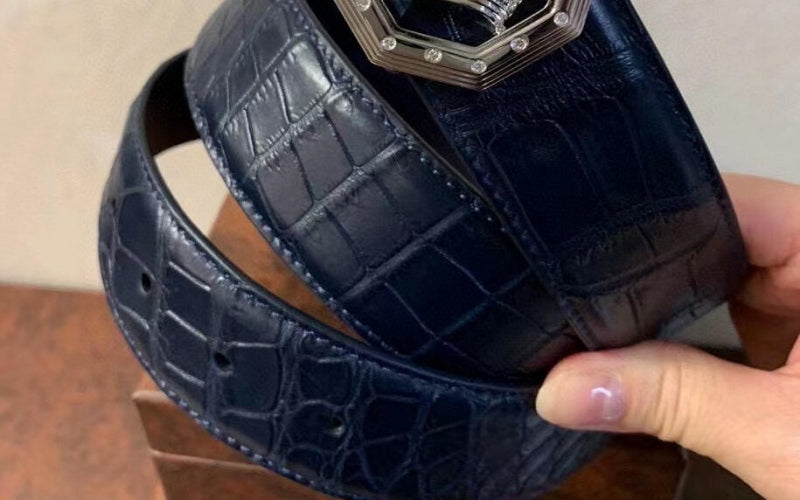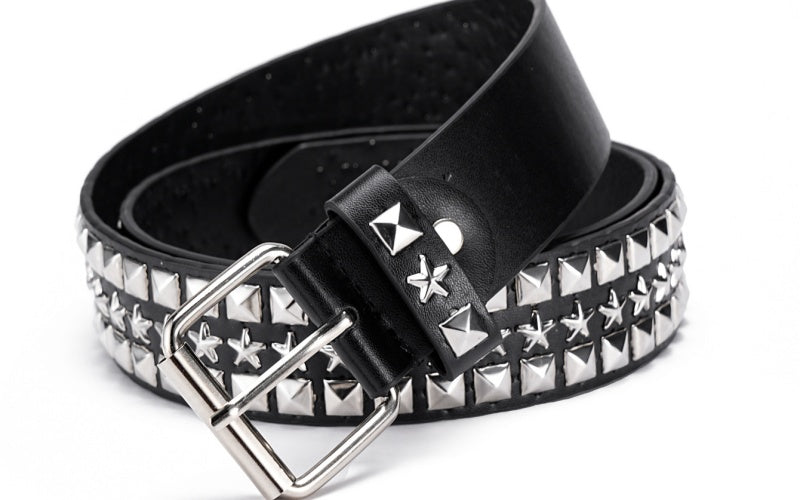
Crocodile Leather Types for Belts (Pros, Cons, and How to Wear Them)
So, you’re thinking about buying a crocodile leather belt. Maybe you want to impress your boss, flex at a wedding, or finally feel like the Bond villain you were born to be.
But before you drop a small fortune on reptile skin, let’s talk about the real deal: the different types of croc leather, their pros and cons, and why your conscience might scream louder than your credit card.
As someone who’s worked with exotic leathers (and survived the side-eyes from eco-conscious friends), I’ll break down everything you need to know—from the swamp to your closet.
 This belt caught your eye? See our alligator collection — click picture above.
This belt caught your eye? See our alligator collection — click picture above.
1. The Crocodile Leather Lowdown: What Makes It So Special?
Crocodile leather isn’t just leather—it’s a status symbol, a conversation starter, and a masterclass in craftsmanship. Here’s why it’s hyped:
-
Unique texture: Raised scales (called “osteoderms”) create a 3D effect that screams luxury.
-
Durability: Croc skin is tougher than your ex’s dating profile. It resists scratches, water, and time.
-
Rarity: Farming crocodiles is labor-intensive, making it 10x pricier than cowhide.
But not all croc leather is the same. Let’s meet the contenders.
 This belt caught your eye? See our alligator collection — click picture above.
This belt caught your eye? See our alligator collection — click picture above.
2. Nile Crocodile: The King of Consistency
Where it’s from: Africa’s rivers and lakes.
Appearance:
-
Small, symmetrical scales with a porous texture.
-
Soft, pebbled belly tiles (the “brisket” area).
Pros:
-
Durable yet supple: Perfect for daily wear. Unlike stiff cowhide, Nile croc bends easily without cracking.
-
Takes dye beautifully: Want emerald green or metallic gold? Nile croc nails vibrant colors.
-
Ethical transparency: Many Nile farms are CITES-certified (more on this later).
Cons:
-
Expensive: Belts start around $1,500 and go up faster than a Tesla’s acceleration.
-
Ethical gray areas: While some farms are regulated, others… let’s just say PETA wouldn’t approve.
Best for: Folks who want a “forever belt” and don’t mind the price tag.
 This belt caught your eye? See our alligator collection — click picture above.
This belt caught your eye? See our alligator collection — click picture above.
3. Saltwater Crocodile: The Unapologetic Flex
Where it’s from: Australia and Southeast Asia.
Appearance:
-
Large, irregular scales with a wild, jagged look.
-
Glossy, smooth belly that feels like polished marble.
Pros:
-
Thickest skin: Survives rain, sweat, and your kid’s juice spills.
-
Rarity factor: Saltwater crocs are harder to farm, making this leather ultra-exclusive.
-
Aesthetic drama: The uneven scales scream, “I vacation in private jets.”
Cons:
-
Costs a kidney: Belts start at $2,500+. You could buy a used car instead.
-
Stiff break-in period: Feels like strapping a cardboard box to your waist at first.
-
Ethical concerns: Wild saltwater crocs are protected, but farming practices vary.
Best for: Bold dressers and anyone who’s ever said, “Money? Never heard of her.”
 This belt caught your eye? See our alligator collection — click picture above.
This belt caught your eye? See our alligator collection — click picture above.
4. Alligator: The Southern Charmer
Where it’s from: Louisiana swamps (American) or China’s Yangtze River.
Appearance:
-
Uniform, square-ish scales (cleaner than croc’s chaotic vibe).
-
Silky-smooth belly leather.
Pros:
-
Softer feel: Breaks in like buttered toast. Comfortable from day one.
-
Subtle luxury: The uniform scales whisper wealth instead of shouting it.
-
Strict regulations: American alligator farming is heavily monitored for ethics.
Cons:
-
Less durable: Thinner than croc leather. Scratches show easier.
-
Limited color options: Mostly classic tones (black, brown, navy).
-
Long wait times: High demand + strict quotas mean you’ll wait months for custom orders.
Best for: Minimalists who want understated elegance and live in humid climates (gators handle moisture better).
 This belt caught your eye? See our alligator collection — click picture above.
This belt caught your eye? See our alligator collection — click picture above.
5. Caiman: The Budget Reptile
Where it’s from: South America’s Amazon Basin.
Appearance:
-
Smaller, bumpier scales with a “dragon skin” texture.
-
Stiff, rugged belly leather.
Pros:
-
Affordable: Belts start around $300—cheaper than a Gucci wallet.
-
Unique texture: The rough scales add edgy flair to casual outfits.
-
Eco-argument: Often a byproduct of meat farming.
Cons:
-
Stiff as a board: Breaking in a caiman belt feels like wrestling a lawn chair.
-
Prone to cracking: Dry climates? Forget it. Caiman needs constant conditioning.
-
Ethical questions: Wild caiman populations are stable, but farming isn’t always kind.
Best for: Trendsetters on a budget who don’t mind babying their accessories.
 This belt caught your eye? See our alligator collection — click picture above.
This belt caught your eye? See our alligator collection — click picture above.
6. How to Spot Fake Crocodile Leather (Don’t Get Duped!)
Real croc leather costs more than your rent. Here’s how to avoid PVC posers:
-
Check the pores: Genuine scales have tiny hair follicles (like pores). Fakes look stamped-on.
-
Bend it: Real croc creases naturally. Fake leather wrinkles like a crumpled chip bag.
-
Smell test: Authentic croc smells earthy. Fakes reek of plastic or chemicals.
-
Price check: Under $800? It’s fake, fam.
Pro tip: Ask for the tannery name. Legit brands use tanneries like Heng Long (Singapore) or Haas (France).
7. The Ethics of Croc Belts: It’s Complicated
Let’s address the 800-pound crocodile in the room.
The Good:
-
CITES certification: Ensures crocs are farmed, not wild-caught. Look for this on labels.
-
Byproduct use: Some farms use hides from crocs raised for meat (reducing waste).
The Bad:
-
Crowded farms: Crocs are social in the wild but often isolated in tiny pens on farms.
-
Killing methods: Some farms use inhumane practices. Always research the brand.
The Alternatives:
-
Vegan croc: Plastic-based “leather” that’s eco-friendly but won’t last.
-
Stingray: Ethically sourced, bulletproof texture, same flex factor.
Beltley’s stance: We don’t sell exotic leathers. But if you’re set on croc, buy vintage or from CITES-certified sellers.
 This belt caught your eye? See our alligator collection — click picture above.
This belt caught your eye? See our alligator collection — click picture above.
8. Caring for Your Croc Belt: A Labor of Love
Treat your croc belt like a Tamagotchi—neglect it, and it’ll die.
Do:
-
Condition monthly with reptile-specific products (e.g., Saphir Reptan).
-
Store flat to avoid scale cracks.
-
Blot spills ASAP. Water won’t kill it, but tequila stains will.
Don’t:
-
Expose to heat: Direct sunlight = cracked, faded scales.
-
Use generic cleaners: They strip natural oils.
-
Wear with denim: Rough fabric scratches the belly leather.
Pro tip: Rotate your croc belt with others. Even reptiles need a day off.
9. Why Cowhide is Still the GOAT (Sorry, Crocs)
Let’s keep it real: For most people, full-grain cowhide is smarter than croc.
Cowhide Pros:
-
Cost: 1/10th the price ($120 vs. $1,500).
-
Durability: Just as tough, minus the paranoia.
-
Ethics: Cows are already part of the food industry.
Cowhide Cons:
-
No “wow” factor: You won’t impress that influencer you’re stalking.
-
Less unique: Everyone and their barista has a cowhide belt.
Beltley’s move: Our Heritage Collection uses vegetable-tanned cowhide—eco-friendly, durable, and guilt-free.
10. Final Verdict: Should You Buy a Croc Belt?
Yes if:
-
You want a lifetime investment piece.
-
You’re okay with the ethical tightrope.
-
Your wardrobe screams “lounge suit,” not “sweatpants.”
No if:
-
You’d rather feed a family for a month than buy a belt.
-
You’re prone to spilling coffee (RIP, $2,000).
-
You think “quiet luxury” means not discussing your credit card debt.
11. How to Style a Croc Belt Without Looking Like a Mob Boss
-
Casual: Pair a brown croc belt with dark jeans and a linen blazer.
-
Formal: Black croc + tuxedo = instant James Bond vibes.
-
Avoid: Logo buckles, neon colors, or wearing it with actual Crocs shoes.
Still debating? Check out Beltley’s Ethical Leather Guide or drop us a comment. And hey—if you’ve got a croc belt story (triumph or tragedy), share it. We’ll laugh with you.

